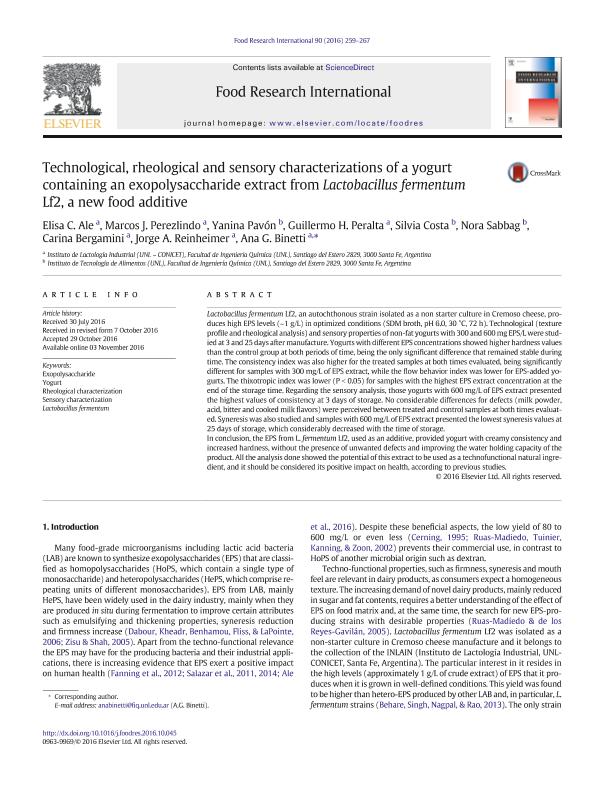Mostrar el registro sencillo del ítem
dc.contributor.author
Ale, Elisa Carmen

dc.contributor.author
Perezlindo, Marcos
dc.contributor.author
Pavón, Yanina Lorena

dc.contributor.author
Peralta, Guillermo Hugo

dc.contributor.author
Costa, Silvia
dc.contributor.author
Sabbag, Nora
dc.contributor.author
Bergamini, Carina Viviana

dc.contributor.author
Reinheimer, Jorge Alberto

dc.contributor.author
Binetti, Ana Griselda

dc.date.available
2018-09-13T13:49:35Z
dc.date.issued
2016-12
dc.identifier.citation
Ale, Elisa Carmen; Perezlindo, Marcos; Pavón, Yanina Lorena; Peralta, Guillermo Hugo; Costa, Silvia; et al.; Technological, rheological and sensory characterizations of a yogurt containing an exopolysaccharide extract from Lactobacillus fermentum Lf2, a new food additive; Elsevier Science; Food Research International; 90; 12-2016; 259-267
dc.identifier.issn
0963-9969
dc.identifier.uri
http://hdl.handle.net/11336/59475
dc.description.abstract
Lactobacillus fermentum Lf2, an autochthonous strain isolated as a non starter culture in Cremoso cheese, produces high EPS levels (~ 1 g/L) in optimized conditions (SDM broth, pH 6.0, 30 °C, 72 h). Technological (texture profile and rheological analysis) and sensory properties of non-fat yogurts with 300 and 600 mg EPS/L were studied at 3 and 25 days after manufacture. Yogurts with different EPS concentrations showed higher hardness values than the control group at both periods of time, being the only significant difference that remained stable during time. The consistency index was also higher for the treated samples at both times evaluated, being significantly different for samples with 300 mg/L of EPS extract, while the flow behavior index was lower for EPS-added yogurts. The thixotropic index was lower (P < 0.05) for samples with the highest EPS extract concentration at the end of the storage time. Regarding the sensory analysis, those yogurts with 600 mg/L of EPS extract presented the highest values of consistency at 3 days of storage. No considerable differences for defects (milk powder, acid, bitter and cooked milk flavors) were perceived between treated and control samples at both times evaluated. Syneresis was also studied and samples with 600 mg/L of EPS extract presented the lowest syneresis values at 25 days of storage, which considerably decreased with the time of storage. In conclusion, the EPS from L. fermentum Lf2, used as an additive, provided yogurt with creamy consistency and increased hardness, without the presence of unwanted defects and improving the water holding capacity of the product. All the analysis done showed the potential of this extract to be used as a technofunctional natural ingredient, and it should be considered its positive impact on health, according to previous studies.
dc.format
application/pdf
dc.language.iso
eng
dc.publisher
Elsevier Science

dc.rights
info:eu-repo/semantics/openAccess
dc.rights.uri
https://creativecommons.org/licenses/by-nc-sa/2.5/ar/
dc.subject
Exopolysaccharide
dc.subject
Lactobacillus Fermentum
dc.subject
Rheological Characterization
dc.subject
Sensory Characterization
dc.subject
Yogurt
dc.subject.classification
Alimentos y Bebidas

dc.subject.classification
Otras Ingenierías y Tecnologías

dc.subject.classification
INGENIERÍAS Y TECNOLOGÍAS

dc.title
Technological, rheological and sensory characterizations of a yogurt containing an exopolysaccharide extract from Lactobacillus fermentum Lf2, a new food additive
dc.type
info:eu-repo/semantics/article
dc.type
info:ar-repo/semantics/artículo
dc.type
info:eu-repo/semantics/publishedVersion
dc.date.updated
2018-09-11T18:02:40Z
dc.journal.volume
90
dc.journal.pagination
259-267
dc.journal.pais
Países Bajos

dc.journal.ciudad
Amsterdam
dc.description.fil
Fil: Ale, Elisa Carmen. Consejo Nacional de Investigaciones Científicas y Técnicas. Centro Científico Tecnológico Conicet - Santa Fe. Instituto de Lactología Industrial. Universidad Nacional del Litoral. Facultad de Ingeniería Química. Instituto de Lactología Industrial; Argentina
dc.description.fil
Fil: Perezlindo, Marcos. Universidad Nacional del Litoral; Argentina
dc.description.fil
Fil: Pavón, Yanina Lorena. Universidad Nacional del Litoral; Argentina
dc.description.fil
Fil: Peralta, Guillermo Hugo. Consejo Nacional de Investigaciones Científicas y Técnicas. Centro Científico Tecnológico Conicet - Santa Fe. Instituto de Lactología Industrial. Universidad Nacional del Litoral. Facultad de Ingeniería Química. Instituto de Lactología Industrial; Argentina
dc.description.fil
Fil: Costa, Silvia. Universidad Nacional del Litoral; Argentina
dc.description.fil
Fil: Sabbag, Nora. Universidad Nacional del Litoral; Argentina
dc.description.fil
Fil: Bergamini, Carina Viviana. Consejo Nacional de Investigaciones Científicas y Técnicas. Centro Científico Tecnológico Conicet - Santa Fe. Instituto de Lactología Industrial. Universidad Nacional del Litoral. Facultad de Ingeniería Química. Instituto de Lactología Industrial; Argentina
dc.description.fil
Fil: Reinheimer, Jorge Alberto. Consejo Nacional de Investigaciones Científicas y Técnicas. Centro Científico Tecnológico Conicet - Santa Fe. Instituto de Lactología Industrial. Universidad Nacional del Litoral. Facultad de Ingeniería Química. Instituto de Lactología Industrial; Argentina
dc.description.fil
Fil: Binetti, Ana Griselda. Consejo Nacional de Investigaciones Científicas y Técnicas. Centro Científico Tecnológico Conicet - Santa Fe. Instituto de Lactología Industrial. Universidad Nacional del Litoral. Facultad de Ingeniería Química. Instituto de Lactología Industrial; Argentina
dc.journal.title
Food Research International

dc.relation.alternativeid
info:eu-repo/semantics/altIdentifier/url/http://ac.els-cdn.com/S0963996916305178/1-s2.0-S0963996916305178-main.pdf?_tid=bb9c1782-a83c-11e6-9430-00000aab0f26&acdnat=1478889128_f0919129cdbf962afffd4999185bbbe7
dc.relation.alternativeid
info:eu-repo/semantics/altIdentifier/doi/http://dx.doi.org/10.1016/j.foodres.2016.10.045
Archivos asociados
